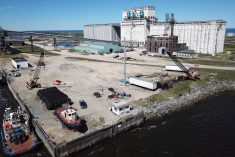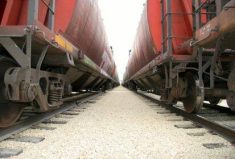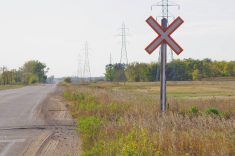David Emerson says people are getting bogged down in the detail and missing the big picture of a report on the Canada Transportation Act.
The former federal cabinet minister chaired a five-member panel that authored the report, and these were his first public remarks since presenting the report to government last December.
“The report was really intended to look out 25 to 30 years,” he told the Commons transport committee.
Getting Canada’s transportation system working well is “the No. 1 way to ensure the competitiveness of the country going forward,” he stressed.
Read Also

Local farm businesses, groups look forward to Manitoba Ag Days 2026
Most of agriculture is seemingly at Manitoba Ag Days each January: Manitoba agribusinesses and farm groups look forward to connecting with farmers at the 2026 show.
Transportation has become more important to trade success than trade policy, he said, noting that it’s common for commercial activities to cover the globe and low tariffs mean borders aren’t much barrier.
“Transportation actually is a larger component of overall cost structures than almost anything you can think of on the trade front,” Emerson said.
The question for Canadians is how to be competitive in two or three decades, and that’s not a long time in the transportation sector, he said.
Transportation regulation has to be crafted in a “very, very long-term perspective in order to enable what is a very, very complex transportation system to adjust to any changes that are material in terms of policy and regulation, he added.
The report was “not intended to be a micro here-and-now to-do list,” he said. “The most important thing for the government to do is get decision-making right.” Decisions about transportation have “to be extremely well informed by good information. Yes, we have individual recommendations throughout the report, but if you don’t get governance right, you’re really not doing very much. You’re playing around at the edges.”
With that he dealt with questions about the report’s recommendation to sunset the extended interswitching limit the Harper government enacted in 2014 as part of a package to deal with chaos in Prairie grain transportation.
He said the debate over interswitching is a “very narrow debate because it applies only to certain provinces and only applies to grain. It is an attempt to add a dimension of competition into a system, which to be very blunt is rife with power imbalances between major service providers and small shippers… Interswitching is one small tool to help the agricultural sector around that.”
Preserving the current 160-kilometre limit would not be “a big problem, to be honest with you,’” he said. “But I do think it’s a big problem if there isn’t consideration to a longer-term evolution to allow a broader interswitching capacity going forward. We really should be not just focusing on interswitching as it relates to grain, or as it relates to three provinces. We need to look at interswitching in a larger sense.”
More important is the review’s recommendation for a remandating of the Canadian Transportation Agency, he urged. Equipped with an enhanced resource base, “the agency could make determinations across a whole range of shippers who feel that they are disadvantaged by their local situation or local service provider. And give the agency the flexibility to mandate interswitching. It could be 160, it could be more than that or less than that. Ideally it should probably cover other commodities as well. Our view was, the 160 is arbitrary, it’s narrow in terms of public policy considerations and should be broadened.
“The transportation system and transportation policy have evolved over the last few decades from a deeply regulated, government-heavy transportation system to one that is very highly market oriented these days,” he pointed out. “There is a need within government for a broader focus on transportation as a key foundation of government economic policy. That has to be beyond the CTA, which has a more restricted regulatory focus and I do believe that you do need advisory mechanisms that include the various elements of the transportation and logistics system and you need a significant amount of input from financial institutions as well because to really enable the transportation system to grow and thrive in the future takes a lot more money than the government can possibly throw at it and you’re going to need the private sector to come to the table. Government is going to have to learn how to enable the private sector to make a bigger contribution.”
At the same time, the federal government must “play a leadership role in ensuring if not the sanctity at least the durability and preservation of critical transportation and logistic corridors going forward because urban encroachment and various other disruptions can create bottlenecks and true competitive crises and problems if those corridors are not preserved and enabled to operate fluidly and efficiently,” he stated.















